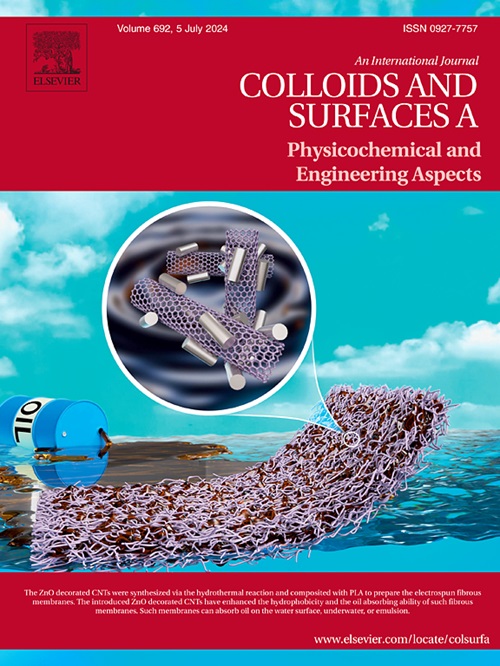In-situ growth of CuAl-LDHs on vermiculite nanolayers for assembling thermostable and anti-bacterial films
IF 5.4
2区 化学
Q2 CHEMISTRY, PHYSICAL
Colloids and Surfaces A: Physicochemical and Engineering Aspects
Pub Date : 2025-07-17
DOI:10.1016/j.colsurfa.2025.137765
引用次数: 0
Abstract
Biodegradable polyvinyl alcohol (PVA) is the most commercially important polymer used in many fields, while suffering from poor stability and a lack of antimicrobial property. In this study, we propose a lattice-matching strategy for the in-situ growth of cationic CuAl-LDHs on anionic vermiculite (VMT) nanosheets. The hierarchical architecture of the VMT/CuAl-LDH nanoparticles (VL-NPs), achieved through interfacial Al-O covalent bonding, exposes abundant active sites while suppressing LDH agglomeration. The resultant VL-NPs are incorporated into the PVA to assemble composite films with superior thermal stability and antibacterial properties. Moreover, the composite film showed inhibition rate to the growth of E. coli and S. aureus achieve to 70 % and 65 % at an addition of 9 wt%, respectively. Further functionalization via organic intercalation (e.g., Cetyltributylphosphonium bromide, CTBPB) enables complete bacterial suppression (100 % inhibition) at 3 wt% loading. This work establishes a scalable platform for designing high-performance organic-inorganic hybrids, advancing the application of biodegradable PVA in food packaging and antimicrobial coatings through synergistic structural and functional engineering.
在蛭石纳米层上原位生长CuAl-LDHs制备耐热抗菌膜
可生物降解聚乙烯醇(PVA)是应用于许多领域的最重要的商业聚合物,但其稳定性差且缺乏抗菌性能。在这项研究中,我们提出了一种晶格匹配策略,用于在阴离子蛭石(VMT)纳米片上原位生长阳离子cual - ldh。通过界面Al-O共价键实现的VMT/CuAl-LDH纳米颗粒(VL-NPs)的分层结构,在抑制LDH团聚的同时暴露了丰富的活性位点。所得的VL-NPs被加入到PVA中,以组装具有优异热稳定性和抗菌性能的复合膜。在添加量为9 wt%时,复合膜对大肠杆菌和金黄色葡萄球菌的生长抑制率分别达到70 %和65 %。通过有机插层进一步功能化(例如,十六烷基三丁基溴化磷,CTBPB)可以在3 wt%负载下完全抑制细菌(100 %抑制)。本研究为高性能有机-无机复合材料的设计提供了一个可扩展的平台,通过协同的结构和功能工程,推进可生物降解聚乙烯醇在食品包装和抗菌涂料中的应用。
本文章由计算机程序翻译,如有差异,请以英文原文为准。
求助全文
约1分钟内获得全文
求助全文
来源期刊
CiteScore
8.70
自引率
9.60%
发文量
2421
审稿时长
56 days
期刊介绍:
Colloids and Surfaces A: Physicochemical and Engineering Aspects is an international journal devoted to the science underlying applications of colloids and interfacial phenomena.
The journal aims at publishing high quality research papers featuring new materials or new insights into the role of colloid and interface science in (for example) food, energy, minerals processing, pharmaceuticals or the environment.

 求助内容:
求助内容: 应助结果提醒方式:
应助结果提醒方式:


